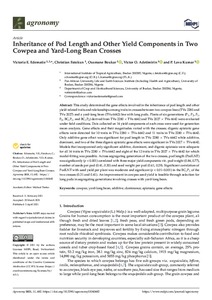| dc.contributor.author | Edematie, V.E. |
| dc.contributor.author | Fatokun, C. |
| dc.contributor.author | Boukar, O. |
| dc.contributor.author | Adetimirin, V.O. |
| dc.contributor.author | Kumar, P.L. |
| dc.date.accessioned | 2021-06-24T12:11:58Z |
| dc.date.available | 2021-06-24T12:11:58Z |
| dc.date.issued | 2021 |
| dc.identifier.citation | Edematie, V.E., Fatokun, C., Boukar, O., Adetimirin, V.O. & Kumar, P.L. (2021). Inheritance of pod length and other yield components in two cowpea and yard-long bean crosses. Agronomy, 11(4), 682: 1-17. |
| dc.identifier.issn | 2073-4395 |
| dc.identifier.uri | https://hdl.handle.net/20.500.12478/7147 |
| dc.description.abstract | This study determined the gene effects involved in the inheritance of pod length and other yield-related traits and relationships among traits in crosses between two cowpea lines (TVu 2280 and TVu 2027) and a yard-long bean (TVu 6642) line with long pods. Plants of six generations (P1, P2, F1, F2, BC1P1, and BC1P2) derived from TVu 2280 × TVu 6642 and TVu 2027 × TVu 6642 were evaluated under field conditions. Data collected on 14 yield components of each cross were used for generation mean analysis. Gene effects and their magnitudes varied with the crosses; digenic epistatic gene effects were detected for 10 traits in TVu 2280 × TVu 6642 and 11 traits in TVu 2280 × TVu 6642. Only additive gene effect was significant for pod length in TVu 2280 × TVu 6642 while additive, dominant, and two of the three digenic epistatic gene effects were significant in TVu 2027 × TVu 6642. Models that incorporated only significant additive, dominant, and digenic epistasis were adequate for all 14 traits in TVu 2280 × TVu 6642 and eight of the 12 traits in TVu 2027 × TVu 6642 for which model-fitting was possible. Across segregating generation of the two crosses, pod length (PodLNT) was significantly (p < 0.001) correlated with three major yield components viz. pod weight (0.84, 0.77), number of seeds per pod (0.41, 0.30) and seed weight per pod (0.61, 0.29). Significant correlation of PodLNT with seed yield per plant was moderate and significant (p < 0.01–0.001) in the BC1P1 of the two crosses (0.31 and 0.41). An improvement in cowpea seed yield is feasible through selection for long pods in segregating generations involving crosses with yard-long bean. |
| dc.description.sponsorship | African Development Bank |
| dc.description.sponsorship | Bill & Melinda Gates Foundation |
| dc.format.extent | 1-17 |
| dc.language.iso | en |
| dc.subject | Cowpeas |
| dc.subject | Beans |
| dc.subject | Additives |
| dc.subject | Epistasis |
| dc.subject | Genes |
| dc.title | Inheritance of pod length and other yield components in two cowpea and yard-long bean crosses |
| dc.type | Journal Article |
| cg.contributor.crp | Grain Legumes |
| cg.contributor.crp | Maize |
| cg.contributor.crp | Roots, Tubers and Bananas |
| cg.contributor.affiliation | International Institute of Tropical Agriculture |
| cg.contributor.affiliation | University of Ibadan |
| cg.coverage.region | Africa |
| cg.coverage.region | West Africa |
| cg.coverage.country | Nigeria |
| cg.coverage.hub | Headquarters and Western Africa Hub |
| cg.researchtheme | Biotech and Plant Breeding |
| cg.researchtheme | Plant Production and Health |
| cg.identifier.bibtexciteid | EDEMATIE:2021 |
| cg.isijournal | ISI Journal |
| cg.authorship.types | CGIAR and developing country institute |
| cg.iitasubject | Agronomy |
| cg.iitasubject | Cowpea |
| cg.iitasubject | Grain Legumes |
| cg.iitasubject | Plant Breeding |
| cg.iitasubject | Plant Health |
| cg.iitasubject | Plant Production |
| cg.journal | Agronomy |
| cg.notes | Open Access Article; Published online: 2 Apr 2021 |
| cg.accessibilitystatus | Open Access |
| cg.reviewstatus | Peer Review |
| cg.usagerightslicense | Creative Commons Attribution 4.0 (CC BY 0.0) |
| cg.targetaudience | Scientists |
| cg.identifier.doi | https://dx.doi.org/10.3390/agronomy11040682 |
| cg.iitaauthor.identifier | Christian Fatokun: 0000-0002-8428-7939 |
| cg.iitaauthor.identifier | P. Lava Kumar: 0000-0003-4388-6510 |
| cg.futureupdate.required | No |
| cg.identifier.issue | 4: 682 |
| cg.identifier.volume | 11 |
| cg.contributor.acknowledgements | The first author acknowledges the Cowpea Breeding Unit of the International Institute of Tropical Agriculture, Ibadan, Nigeria which activities during this research work was supported by the Bill and Melinda Gates Foundation under the Tropical Legumes Project. The scholarship and research grant provided by the African Union and African Development Bank through the Pan African University Life and Earth Science Institute (PAULESI) to carry out this study as part of the Ph.D. research of the first author is thankfully acknowledged. |

